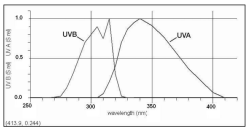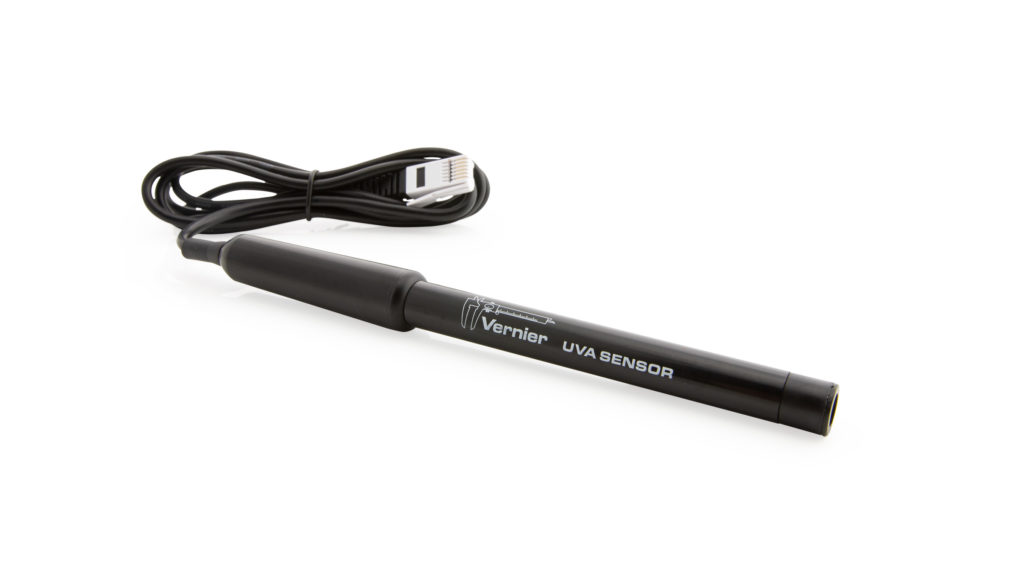UVA Sensor User Manual
Order Code: UVA-BTA
The UVA Sensor is an ultraviolet light sensor that responds primarily to UVA radiation (approx. 320 to 390 nm). The UVA sensor is recommended for experiments that use a UV lamp.
Note: Vernier products are designed for educational use. Our products are not designed nor are they recommended for any industrial, medical, or commercial process such as life support, patient diagnosis, control of a manufacturing process, or industrial testing of any kind.
Compatible Software
Choose a platform below to see its compatibility requirements.LabQuest
Interface LabQuest App LabQuest 3 Full support LabQuest 2 Full support LabQuest Full support Computers
Software Interface Graphical Analysis Graphical Analysis (Web App) Logger Pro (discontinued) Logger Lite (discontinued) LabQuest Mini Full support Full support Full support Full support LabQuest 3 Full support Full support Full support Incompatible LabQuest 2 Full support Full support Full support Full support LabQuest Stream Full support 1 Full support 1 Partial support 2 Full support 1 Go!Link Full support Full support Full support Full support LabQuest Full support Full support Full support Full support LabPro Incompatible Incompatible Full support Full support Compatibility Notes
Chromebook
Software Interface Graphical Analysis (Web App) LabQuest Mini Full support LabQuest 3 Full support LabQuest 2 Full support LabQuest Stream Full support 1 Go!Link Full support LabQuest Full support Compatibility Notes
iOS
Software Interface Graphical Analysis Graphical Analysis GW LabQuest Stream Full support Full support LabQuest 3 Full support 1 Full support 1 LabQuest 2 Full support 1 Full support 1 Compatibility Notes
Android
Software Interface Graphical Analysis Graphical Analysis GW LabQuest Stream Full support Full support LabQuest 3 Full support 1 Full support 1 LabQuest 2 Full support 1 Full support 1 Compatibility Notes
Arduino
Software Interface Arduino Vernier Arduino® Interface Shield Full support LabVIEW
Software Interface NI LabVIEW SensorDAQ Full support Vernier myDAQ Adapter Full support 1 Go!Link Full support LabQuest Mini Full support LabQuest Stream Full support LabQuest 3 Full support LabQuest 2 Full support LabQuest Full support Compatibility Notes
Texas Instruments
Software Interface EasyData DataMate TI-84 SmartView DataQuest TI-Nspire Software EasyLink Full support 1 Incompatible Full support 2 Full support Full support 2 CBL 2 Full support 3 Full support 3 4 Incompatible Incompatible Incompatible LabPro Full support 3 Full support 3 4 Incompatible Incompatible Incompatible TI-Nspire Lab Cradle Incompatible Incompatible Incompatible Full support Full support Compatibility Notes
Quick Start
- Plug the sensor into the interface (LabQuest 3, LabQuest Mini, etc.).
- Connect the interface to your device.
- If using USB, connect to the USB port on your computer.
- If using Bluetooth® wireless technology, click your interface type and then select your device.
- Prepare for data collection:
- Vernier Graphical Analysis®: Launch the app, if necessary, and click Sensor Data Collection.
- LabQuest® App: Choose New from the File menu.
The software will identify the sensor and load a default data-collection setup. You are now ready to collect data.
Need Additional Information?
Visit the following link:
Calibrating the Sensor
You do not have to perform a new calibration when using the UVA sensor. You can use the calibration that is stored on the sensor itself.
It is quite difficult to calibrate a UV sensor to read in absolute units, since you must have a source of known UV intensity and spectral distribution. More often you will simply want to calibrate the sensor in terms of a relative intensity. In that case, you will point the sensor at a UV source (most often the sun) and define that intensity as 100%. To perform this kind of calibration, complete the following steps for a two-point calibration. One of the points is your zero, with no light striking the sensor. Cover the tip of the UVA sensor with a clean opaque object. Select the calibration option of the program you are using. Enter 0 (zero) as the first known intensity. Now allow full UV intensity to strike the sensor. Since the orientation of the sensor affects the reading, it is best to hold the sensor in place with a clamp on a ring stand. To point the sensor directly at the sun, make the shadow of the sensor tube as small as possible. Enter 100 as the next known intensity. Subsequent measurements will be relative to this second intensity.
Note that you cannot calibrate a light sensor using a broadband light source (such as a lamp or the sun) against another light sensor of known calibration unless the spectral response of the two sensors is exactly the same. Similarly, any intensity measurements of a broadband source using two sensors with different spectral response cannot be directly compared. For example, a reading from another manufacturer’s UVA sensor would not correspond to the readings from the Vernier UVA Sensor. In all these cases a direct comparison is not appropriate, since the reading from any light sensor is a convolution of the spectral distribution of the incident light and the spectral response of the sensor.
Specifications
|
UV peak sensitivity |
one volt per 3940 mW/m² at 340 nm |
|
Wavelength sensitivity region, approximate |
320 to 390 nm (320 to 375 nm, half‑sensitivity points) |
|
12-bit resolution |
5 mW/m² |
|
Dimensions |
21 cm by 2 cm diameter |
|
Time response |
approximately 2 seconds to reach 95% of final reading |
|
Stored calibration |
slope (gain): 3940 mW/(m² V) intercept (offset): 0 |
|
Irradiance |
Vout * 3940 mW/(m² V) |
Care and Maintenance
Do not wrap the cable tightly around the sensor for storage. Repeatedly doing so can irreparably damage the wires and is not covered under warranty.
How the Sensor Works
The Vernier UVA Sensor is built around a broadband UV sensitive silicon photodiode. The diode produces a current proportional to the UV intensity. A wavelength selective filter limits light striking the diode to only the UVA region. The signal from the diode is amplified and sent to the output.
UV Terminology
The Vernier UVA and UVB (order code UVB-BTA) Sensors respond to specific regions of the electromagnetic spectrum. The wavelength region from 320 to 400 nm is commonly called UVA radiation, and 280 to 320 nm is called UVB radiation. Wavelengths shorter than 280 nm fall into the UVC spectrum. Neither Vernier sensor is sensitive to UVC radiation.

Plants and animals respond differently to the three types of UV radiation. Although very harmful to plants and animals, UVC radiation is nearly completely absorbed by the ozone in the Earth’s atmosphere. Some UVB radiation makes it through the atmosphere, although the degree of absorption depends critically on the angle of the sun and the amount of ozone along the light path. UVB radiation is thought to be responsible for reddening of the skin (erythema), cataracts, and skin cancers. UVA can also cause these effects on human skin, but to a lesser extent. It is generally agreed that UVB radiation is the primary danger to humans, but increasingly UVA is being shown to cause delayed, but significant, damage to skin and eyes. The standard erythemal (or sunburning) action spectrum (McKinlay and Diffey, 1987) represents a combined estimate of the relative sensitivity of skin as a function of wavelength. Since knowledge of how UV light affects skin improves with time, the erythemal spectrum may not represent the latest thinking of UV danger.
There are several ways of measuring UV light intensity and exposure. The usual irradiance unit of measurement is mW/cm², but a simplified UV Index system is also in use. The UV Index is actually a forecast, not a measurement. For comparison with the forecast, some UV sensors can be calibrated in terms of UV Index. However, since the UV Index includes a wavelength weighting corresponding to the erythemal action spectrum, only sensors matching the erythemal spectrum can logically be calibrated in terms of UV Index. The UVA sensor therefore cannot report UV index.
Troubleshooting
For troubleshooting and FAQs, see www.vernier.com/til/1441
Repair Information
If you have watched the related product video(s), followed the troubleshooting steps, and are still having trouble with your Product Name, contact Vernier Technical Support at support@vernier.com or call 888-837-6437. Support specialists will work with you to determine if the unit needs to be sent in for repair. At that time, a Return Merchandise Authorization (RMA) number will be issued and instructions will be communicated on how to return the unit for repair.
Warranty
Warranty information for this product can be found on the Support tab at www.vernier.com/uva-bta/#support
General warranty information can be found at www.vernier.com/warranty
Disposal
When disposing of this electronic product, do not treat it as household waste. Its disposal is subject to regulations that vary by country and region. This item should be given to an applicable collection point for the recycling of electrical and electronic equipment. By ensuring that this product is disposed of correctly, you help prevent potential negative consequences on human health or on the environment. The recycling of materials will help to conserve natural resources. For more detailed information about recycling this product, contact your local city office or your disposal service.
Contact Support
Fill out our online support form or call us toll-free at 1-888-837-6437.

